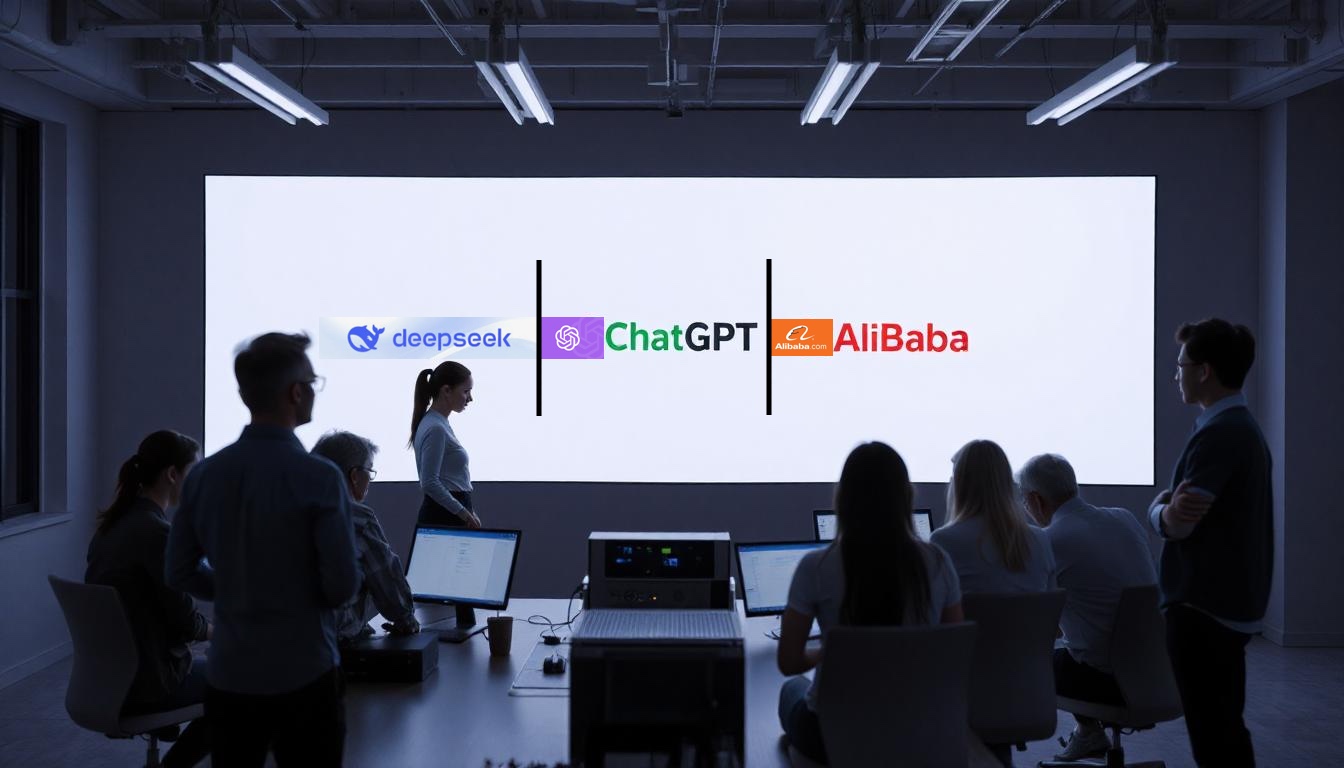Governance, Industry Adoption & Open-Source AI Explained 🚀💡: DeepSeek vs. OpenAI & Alibaba
- Janus-Pro vs. DALL-E 3
- Governance, Industry Adoption & Open-Source AI Explained 🚀💡: DeepSeek vs. OpenAI & Alibaba
- DeepSeek vs. ChatGPT
- OpenAI: Disrupting the Norm with Sora
- OpenAI’s O3
- Everything You Need to Know About Grok-3
Thank you, Upendra Jadon, for your insightful questions and kind words in the previous post DeepSeek vs. ChatGPT! DeepSeek’s rapid rise in AI has indeed sparked many discussions, and I’m excited to dive into your queries. But before that let’s address the elephant in the room.
Alibaba’s AI Claim: Is Qwen 2.5-Max Really Better Than DeepSeek and ChatGPT?
Alibaba recently announced its latest AI model, Qwen 2.5-Max, claiming it surpasses DeepSeek-V3 and even challenges ChatGPT (GPT-4) in performance. This claim has generated significant buzz in the AI community, but how does it hold up under scrutiny? Let’s break it down.
Understanding Qwen 2.5-Max 📊🔍
Qwen 2.5-Max is part of Alibaba’s open-source Qwen series and is designed to handle longer, more complex querieswith improved conversational depth. The model is being rapidly adopted in industries such as automotive, finance, retail, and enterprise automation, where it powers customer interactions, product development, and business intelligence applications.
Alibaba asserts that Qwen 2.5-Max outperforms DeepSeek-V3, OpenAI’s GPT-4, and Meta’s Llama-3.1-405B across multiple benchmarks—but does it really?
Qwen 2.5-Max vs. DeepSeek-V3 vs. ChatGPT: A Side-by-Side Comparison⚖️
| Feature | Qwen 2.5-Max (Alibaba) | DeepSeek-V3 | ChatGPT (GPT-4) |
|---|---|---|---|
| Developer | Alibaba Cloud | DeepSeek | OpenAI |
| Model Type | Large Language Model | Large Language Model | Large Language Model |
| Release Date | January 29, 2025 | January 10, 2025 | March 2023 |
| Performance | Claims to surpass GPT-4, DeepSeek-V3, and Llama-3.1-405B | Outperformed GPT-4 and Gemini on AIME 2024 & MMLU | Versatile, strong in multi-domain tasks |
| Efficiency | Not specified | Achieves high performance with fewer computational resources | Requires significant computational power |
| Cost | Not specified | Cost-efficient, 27x cheaper inference than GPT-4 | High training and operational costs |
| Deployment | Used in enterprise AI, e-commerce, and finance | Used in scientific computing, finance, and cybersecurity | General AI applications across multiple industries |
| Governance & Transparency | Regulatory-compliant, China-focused AI strategy | Fully open-source with transparent AI model | Proprietary, limited transparency |
Evaluating Alibaba’s Claim 🧐💡
1️⃣ Benchmark Performance
Alibaba asserts that Qwen 2.5-Max beats DeepSeek-V3 and ChatGPT across multiple benchmarks, but exact benchmark details remain undisclosed. Without independent evaluations, it is difficult to validate these claims against rigorous industry standards.
2️⃣ Resource Efficiency & Cost
One of DeepSeek’s biggest strengths is its low compute cost and efficiency-driven architecture (Mixture-of-Experts), making it highly scalable for enterprises. Alibaba has not provided clarity on the computational efficiency or cost of running Qwen 2.5-Max. If it requires similar or higher resources than GPT-4, it may not be as efficient as DeepSeek.
3️⃣ Adoption & Real-World Applications
Both Qwen 2.5-Max and DeepSeek-V3 are rapidly gaining adoption. Alibaba’s model is tailored toward China’s regulatory and enterprise ecosystem, while DeepSeek’s fully open-source model is attracting a global developer and enterprise community. OpenAI’s ChatGPT, on the other hand, remains a dominant force in consumer and business AI solutions worldwide.
Final Verdict: Is Qwen 2.5-Max Really the Best? 🏆
Alibaba’s Qwen 2.5-Max may indeed be a strong contender in the AI landscape, but without more transparency on benchmarks, efficiency, and deployment cost, it is premature to say it truly surpasses DeepSeek-V3 or ChatGPTacross all domains.
- If Alibaba’s claims are verified, it could become a powerful alternative for enterprise AI in China and beyond.
- If efficiency and cost-effectiveness matter, DeepSeek-V3 still holds the edge with its 27x lower inference costand transparent model architecture.
- For multimodal AI and conversational fluency, ChatGPT remains a leader in creative, general-purpose AI applications.
As more data emerges, it will be interesting to see how Qwen 2.5-Max stacks up in independent evaluations. For now, DeepSeek remains the most cost-efficient challenger to OpenAI, while Alibaba’s ambitions will depend on real-world validation. 🚀
Now let’s address three important topic related to it!
1️⃣ AI Governance & Transparency: DeepSeek vs. OpenAI vs. Alibaba 🏛️🔍
One of the defining aspects of AI today is governance and transparency, and DeepSeek’s approach differs significantly from OpenAI and Alibaba:
- DeepSeek has emphasized an open-source and permissive licensing model, making it more transparent than its competitors. By fully disclosing its reasoning steps, DeepSeek allows researchers, developers, and enterprises to audit and refine its AI without black-box concerns.
- OpenAI, while pioneering AI advancements, has become more closed off in recent years, especially with the limited public access to GPT-4 and GPT-4o’s inner workings. Their shift from open research to for-profit governance under Microsoft’s influence has led to debates about AI transparency.
- Alibaba, as a major Chinese tech player, follows a government-aligned AI strategy, ensuring compliance with strict regulatory oversight in China while offering enterprise AI services. Their AI governance approach prioritizes state approval and regional AI safety protocols, differing from both DeepSeek and OpenAI in terms of global accessibility.
DeepSeek’s commitment to open AI governance positions it as a potential leader in trustworthy and accessible AI—something enterprises and developers will likely favor.
2️⃣ Industry Adoption: Who Will Leverage DeepSeek First? 🏭💼
DeepSeek’s efficiency and cost-effectiveness make it attractive for industries that require structured problem-solving, automation, and AI-driven insights. Here are some industries where DeepSeek is likely to gain traction first:
🔹 Financial Services – Algorithmic trading, fraud detection, and risk management will benefit from DeepSeek’s structured reasoning capabilities. 🔹 Healthcare & Life Sciences – Medical research, diagnostics, and AI-assisted treatment recommendations require models that balance efficiency with explainability. 🔹 Legal & Compliance – AI-driven contract analysis, regulatory compliance, and case law research are prime areas for DeepSeek’s structured approach. 🔹 Cybersecurity – Threat detection, network monitoring, and AI-assisted cyber defense can leverage DeepSeek’s low-latency, high-accuracy responses. 🔹 Enterprise SaaS & Automation – Businesses looking to cut AI inference costs while maintaining high performance may switch to DeepSeek for AI-driven customer service, analytics, and intelligent process automation.
How will it compete in enterprise AI?
DeepSeek’s cost advantage (🔹 27x cheaper inference than OpenAI) and transparent AI architecture will likely make it an appealing alternative for enterprises seeking high-performance AI at scale. Expect to see DeepSeek partner with cloud providers, integrate into AI-powered enterprise tools, and compete in the AI-powered enterprise assistant space.
3️⃣ Open-Sourcing AI at DeepSeek’s Scale: Risks & Benefits 🌍🔓
DeepSeek’s commitment to open-source AI brings both unparalleled advantages and notable risks:
✅ Advantages of Open-Sourcing AI
One of the biggest advantages of DeepSeek’s open-source approach is that anyone can download it and run it locally. This accessibility eliminates dependency on cloud-based AI providers and enables companies, researchers, and developers to integrate AI directly into their own infrastructure.
- Self-Hosted AI: Businesses can run DeepSeek on-premise, ensuring data privacy and security without relying on third-party cloud services.
- Customization & Fine-Tuning: Open-source AI allows enterprises to fine-tune the model for their specific needs, enhancing performance in domain-specific applications.
- Lower Infrastructure Costs: Without cloud-based API fees, startups and research institutions can experiment with AI without incurring significant costs.
- Edge Computing & Decentralization: By running locally, DeepSeek enables AI applications in low-latency, offline environments, which is particularly beneficial for IoT devices, robotics, and embedded systems.
This openness is a game-changer for enterprise AI adoption, enabling organizations to leverage AI at scale without vendor lock-in or excessive costs. ✔️ Transparency & Trust: Open-source AI allows developers and researchers to audit, verify, and enhance models without restrictions. ✔️ Faster Innovation: A global AI community can refine DeepSeek’s capabilities, much like how open-source projects like Linux or TensorFlow have evolved. ✔️ Lower AI Costs for Enterprises: Open access to DeepSeek can help businesses reduce AI expenses, enabling AI-driven automation at scale. ✔️ Decentralized AI Advancement: Open-source AI ensures that AI innovation isn’t monopolized by a few tech giants, leading to more equitable AI development.
⚠️ Risks of Open-Sourcing AI
⚠️ Misuse & Security Concerns: Open-source AI models can be repurposed for malicious intent, including AI-powered cyberattacks or misinformation campaigns. ⚠️ Lack of Monetization for Developers: Open models can reduce financial incentives for AI developers if businesses avoid paying for AI services. ⚠️ Regulatory Challenges:Governments may seek more control over open AI models, leading to legal hurdles for global deployment. ⚠️ AI Bias & Manipulation Risks: Without centralized oversight, bad actors could intentionally modify AI behavior, leading to biased or unethical AI systems.
The Verdict? DeepSeek’s approach aligns with the spirit of open innovation, but managing security, ethical concerns, and AI safety will be crucial to its long-term success.
How to Run DeepSeek Locally 🖥️⚙️
One of the most compelling aspects of DeepSeek is its ability to be run locally, eliminating reliance on cloud-based AI providers and allowing for full control over its deployment. Here’s how you can set it up:
1️⃣ System Requirements
To run DeepSeek locally, ensure your system meets the following minimum requirements:
- GPU: Nvidia A100, H100, or equivalent (for optimal performance)
- RAM: 64GB+ (depending on model size)
- Storage: At least 500GB free disk space
- OS: Linux (Ubuntu 20.04+ recommended) or Windows WSL2
- Dependencies: Python 3.8+, CUDA 11.7+, PyTorch
2️⃣ Installation Steps
Follow these steps to download and run DeepSeek:
- Clone the DeepSeek Repository:
git clone https://github.com/deepseek-ai/DeepSeek-R1.git cd DeepSeek-R1 - Create a Virtual Environment and Install Dependencies:
python3 -m venv deepseek_env source deepseek_env/bin/activate pip install -r requirements.txt - Download the Model Weights:
- Visit DeepSeek’s official repository to download the required model weights.
- Place them in the
models/directory.
- Run DeepSeek Locally:
python run.py --model models/deepseek-r1 --gpu - Test the Model:
from deepseek import DeepSeekModel model = DeepSeekModel('models/deepseek-r1') response = model.generate("Explain quantum entanglement.") print(response)
3️⃣ Optimizing Performance
- For lower-end GPUs, use quantization techniques like bitsandbytes or TensorRT.
- For distributed setups, leverage DeepSpeed or FSDP (Fully Sharded Data Parallel) to split model execution across multiple GPUs.
4️⃣ Benefits of Running DeepSeek Locally
✅ Full Data Privacy – No data leaves your machine, making it perfect for secure environments. ✅ Lower Costs – Avoid cloud API fees by leveraging your own hardware. ✅ Customization – Fine-tune and optimize DeepSeek for specific industry applications. ✅ Offline Availability – AI access even in remote or restricted areas.
DeepSeek’s local deployment potential makes it a game-changer for enterprises, researchers, and developers looking to build AI-powered solutions without vendor lock-in.
Final Thoughts 💡🚀
DeepSeek is reshaping the AI landscape with cost-effective, open, and high-performance AI models. While OpenAI and Alibaba are still dominant in their respective domains, DeepSeek’s transparent governance, rapid industry adoption, and open-source strategy make it a disruptive force in enterprise AI.
Thank you again, Upendra, for these great questions! Would love to hear everyone’s thoughts—how do you see DeepSeek’s open AI model impacting the future? Drop your comments below! 👇


